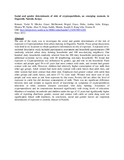Social and gender determinants of risk of cryptosporidiosis, an emerging zoonosis, in Dagoretti, Nairobi, Kenya

View/
Date
2012Author
Kimani, Violet N
Mitoko, Grace
McDermott, Brigid
Grace, Delia
Ambia, Julie
Kiragu, Monica W
Njehu, Alice N
Sinja, Judith
Monda, Joseph G
Kang’ethe, Erastus K
Type
ArticleLanguage
enMetadata
Show full item recordAbstract
The aim of the study was to investigate the social and gender determinants of the risk of exposure to Cryptosporidium fromurban dairying in Dagoretti, Nairobi. Focus group
discussions were held in six locations to obtain qualitative information on risk of exposure. A repeated cross-sectional descriptive study included participatory assessment and household questionnaires (300 randomly selected urban dairy farming households and 100 non-dairying neighbours). One hundred dairy households randomly selected from the 300 dairy households participated in an additional economic survey along with 40 neighbouring non-dairy households. We found that exposure to Cryptosporidium was influenced by gender, age and role in the household. Farm workers and people aged
50 to 65 years had most contact with cattle, and women had greater contact with raw milk. However, children had relatively higher consumption of raw milk than other age groups. Adult women had more daily contact with cattle faeces than adult men, and older women had more contact than older men. Employees had greater contact with cattle than other groups and cattle faeces, and most (77 %) were male. Women took more care of sick people and were more at risk from exposure by this route. Poverty did not affect the level of exposure to cattle but did decrease consumption of milk. There was no significant difference between men and women as regards levels of knowledge on symptoms of cryptosporidiosis infections or other zoonotic diseases associated with dairy farming.
Awareness of cryptosporidiosis and its transmission increased significantly with rising levels of education. Members of nondairy households and children under the age of 12 years had significantly higher odds of reporting diarrhoea: gender, season and contact with cattle or cattle dung were not significantly linked with diarrhoea. In conclusion, social and gender factors are important determinants of exposure to zoonotic disease in
Nairobi.
URI
http://erepository.uonbi.ac.ke:8080/xmlui/handle/123456789/14281http://www.ncbi.nlm.nih.gov/pubmed/22865349
Citation
Trop Anim Health Prod (2012) 44 (Suppl 1):S17–S23Publisher
Department of Community Health, University of Nairobi, Biometry Unit, Department of Crop Science, University of Nairobi, International Livestock Research Institute, Department of Public Health, Faculty of Veterinary Medicine,
